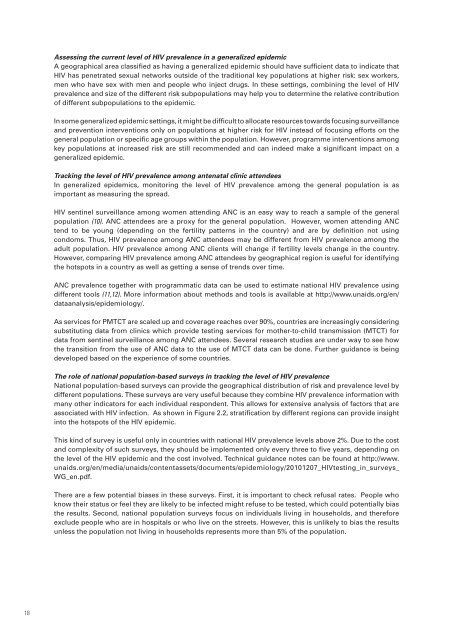Guidelines for second generation HIV surveillance - World Health ...
Guidelines for second generation HIV surveillance - World Health ...
Guidelines for second generation HIV surveillance - World Health ...
Create successful ePaper yourself
Turn your PDF publications into a flip-book with our unique Google optimized e-Paper software.
Assessing the current level of <strong>HIV</strong> prevalence in a generalized epidemic<br />
A geographical area classified as having a generalized epidemic should have sufficient data to indicate that<br />
<strong>HIV</strong> has penetrated sexual networks outside of the traditional key populations at higher risk: sex workers,<br />
men who have sex with men and people who inject drugs. In these settings, combining the level of <strong>HIV</strong><br />
prevalence and size of the different risk subpopulations may help you to determine the relative contribution<br />
of different subpopulations to the epidemic.<br />
In some generalized epidemic settings, it might be difficult to allocate resources towards focusing <strong>surveillance</strong><br />
and prevention interventions only on populations at higher risk <strong>for</strong> <strong>HIV</strong> instead of focusing ef<strong>for</strong>ts on the<br />
general population or specific age groups within the population. However, programme interventions among<br />
key populations at increased risk are still recommended and can indeed make a significant impact on a<br />
generalized epidemic.<br />
Tracking the level of <strong>HIV</strong> prevalence among antenatal clinic attendees<br />
In generalized epidemics, monitoring the level of <strong>HIV</strong> prevalence among the general population is as<br />
important as measuring the spread.<br />
<strong>HIV</strong> sentinel <strong>surveillance</strong> among women attending ANC is an easy way to reach a sample of the general<br />
population (10). ANC attendees are a proxy <strong>for</strong> the general population. However, women attending ANC<br />
tend to be young (depending on the fertility patterns in the country) and are by definition not using<br />
condoms. Thus, <strong>HIV</strong> prevalence among ANC attendees may be different from <strong>HIV</strong> prevalence among the<br />
adult population. <strong>HIV</strong> prevalence among ANC clients will change if fertility levels change in the country.<br />
However, comparing <strong>HIV</strong> prevalence among ANC attendees by geographical region is useful <strong>for</strong> identifying<br />
the hotspots in a country as well as getting a sense of trends over time.<br />
ANC prevalence together with programmatic data can be used to estimate national <strong>HIV</strong> prevalence using<br />
different tools (11,12). More in<strong>for</strong>mation about methods and tools is available at http://www.unaids.org/en/<br />
dataanalysis/epidemiology/.<br />
As services <strong>for</strong> PMTCT are scaled up and coverage reaches over 90%, countries are increasingly considering<br />
substituting data from clinics which provide testing services <strong>for</strong> mother-to-child transmission (MTCT) <strong>for</strong><br />
data from sentinel <strong>surveillance</strong> among ANC attendees. Several research studies are under way to see how<br />
the transition from the use of ANC data to the use of MTCT data can be done. Further guidance is being<br />
developed based on the experience of some countries.<br />
The role of national population-based surveys in tracking the level of <strong>HIV</strong> prevalence<br />
National population-based surveys can provide the geographical distribution of risk and prevalence level by<br />
different populations. These surveys are very useful because they combine <strong>HIV</strong> prevalence in<strong>for</strong>mation with<br />
many other indicators <strong>for</strong> each individual respondent. This allows <strong>for</strong> extensive analysis of factors that are<br />
associated with <strong>HIV</strong> infection. As shown in Figure 2.2, stratification by different regions can provide insight<br />
into the hotspots of the <strong>HIV</strong> epidemic.<br />
This kind of survey is useful only in countries with national <strong>HIV</strong> prevalence levels above 2%. Due to the cost<br />
and complexity of such surveys, they should be implemented only every three to five years, depending on<br />
the level of the <strong>HIV</strong> epidemic and the cost involved. Technical guidance notes can be found at http://www.<br />
unaids.org/en/media/unaids/contentassets/documents/epidemiology/20101207_<strong>HIV</strong>testing_in_surveys_<br />
WG_en.pdf.<br />
There are a few potential biases in these surveys. First, it is important to check refusal rates. People who<br />
know their status or feel they are likely to be infected might refuse to be tested, which could potentially bias<br />
the results. Second, national population surveys focus on individuals living in households, and there<strong>for</strong>e<br />
exclude people who are in hospitals or who live on the streets. However, this is unlikely to bias the results<br />
unless the population not living in households represents more than 5% of the population.<br />
18
















